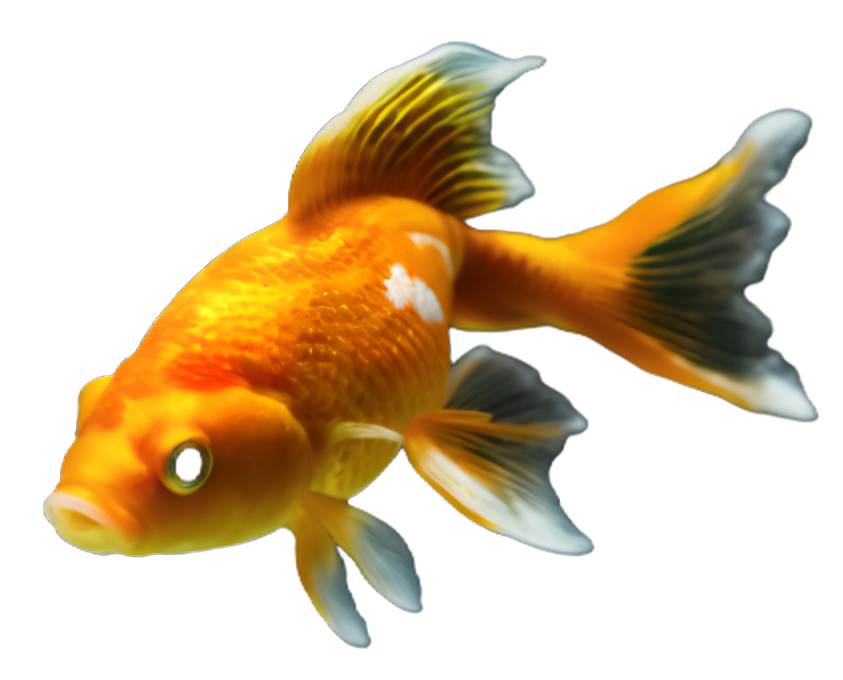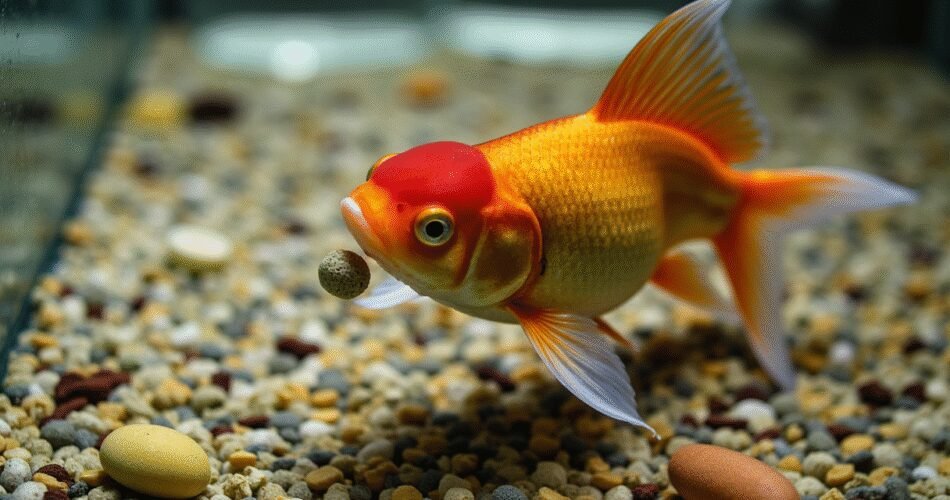Goldfish Feeding and Growth: Why It Matters to Me 🐠
I’ve learned that goldfish feeding is about more than just dropping flakes into the tank—it’s the key to their health and growth. When I feed my goldfish properly, I’m directly supporting their development, color, and immune system. Overfeeding or underfeeding can cause stress, stunted growth, or even disease. That’s why understanding how feeding affects goldfish health is so important to me.
Getting it right means balanced nutrition, controlled portions, and a consistent schedule. I focus on quality food and avoid overloading their digestive systems. Trust me, a well-fed goldfish is an active, vibrant one. Want to know how often to feed goldfish for healthy growth? I’ll help you get it right.
Understanding Goldfish Metabolism 🔬
I’ve learned that goldfish metabolism is surprisingly fast. Their digestive system works quickly, processing food in just a few hours. Because they don’t have stomachs, goldfish digestion rates are high, meaning they need small, frequent meals rather than one large feeding.
How goldfish metabolism affects feeding frequency is crucial for their health. Overfeeding can cause bloating and water quality issues, while underfeeding slows growth. I feed my goldfish small portions two to three times a day, which supports their metabolism without overwhelming their digestive system.
Understanding the digestive system of goldfish helps me keep them thriving. It’s not just about how much, but how often—consistent, light feeding keeps their energy up and their water clean.
How Often Should I Feed My Goldfish? ⏰
When it comes to the feeding frequency for goldfish, I stick to a simple routine: twice a day. I feed my goldfish once in the morning and once in the evening. This daily feeding schedule for goldfish helps keep their digestion steady and supports healthy growth without overloading them.
I make sure each meal is small—only what they can finish in about two minutes. Overfeeding can cause water quality issues and health problems, so portion control is just as important as timing. The optimal feeding times for goldfish align with their natural activity periods, ensuring they metabolize food efficiently.
Consistency is key. I avoid skipping meals or offering extra snacks, as a regular routine promotes balanced nutrition and reduces stress. By following this approach, I keep my goldfish active, vibrant, and growing well.
Factors Influencing How Often I Feed My Goldfish 🌡️
When I’m figuring out how often to feed my goldfish, I consider several feeding frequency factors. It’s not just about sticking to a rigid schedule—it’s about adjusting based on conditions. One big thing I watch is how season affects goldfish feeding. In warmer months, my fish are more active and hungry, so I feed them more often. But in winter, their metabolism slows way down.
Another key factor is the impact of water temperature on feeding goldfish. If the tank is cooler, I cut back on meals to avoid overfeeding and keep the water clean. Age matters too—younger fish need frequent, small meals, while adults do fine with less. I always observe their behavior and adjust accordingly.
Ultimately, feeding my goldfish isn’t one-size-fits-all. I tailor it to their environment and needs to support healthy growth.
Portion Size and Feeding Amounts I Stick To 🥄
I’ve learned that nailing down the right goldfish feeding portions is key to keeping my fish healthy. When I think about how much to feed goldfish, I stick to the two-minute rule: I only give them what they can finish in about two minutes. That’s usually a pinch of flakes or pellets, no bigger than one of their eyeballs. It’s a simple way to make sure I’m providing appropriate feeding amounts for goldfish without going overboard.
Avoiding overfeeding goldfish is just as important as how often I feed them. Leftover food clouds the water and can harm their health. I watch them eat and remove any uneaten bits right away. It keeps the tank clean and my goldfish thriving.
Types of Food I Choose for My Goldfish 🥦
When I think about the best food for goldfish growth, I always consider their nutritional needs. Goldfish food types vary, but I stick to a balanced mix to keep them healthy and vibrant.
I start with high-quality flakes or pellets, which cover the basics of a goldfish diet. These are packed with proteins and vitamins essential for growth and energy. I also include live or frozen treats like brine shrimp or bloodworms a few times a week. These provide extra protein and keep my goldfish active.
For the varieties of goldfish diet, I add veggies like peas (shelled) and spinach. They’re great for digestion and add necessary fiber. I always remember that overfeeding is a risk, so I follow guidelines on how often to feed goldfish—usually small portions twice a day. This routine supports their health and avoids waste in the tank.
Signs of Overfeeding and Underfeeding I Watch For 👀
I’ve learned to watch closely for signs of overfeeding or underfeeding in my goldfish. It’s not just about how often to feed goldfish—it’s about recognizing feeding issues early.
When I overfeed, I notice cloudy water, uneaten food, and bloating in my fish. Overfeeding goldfish signs like these can lead to serious health issues, including swim bladder disorder and poor water quality. On the other hand, underfeeding goldfish symptoms include lethargy, weight loss, and constant begging for food. These feeding mistakes on goldfish health can weaken their immune systems and stunt their growth.
Getting the balance right is crucial. I make sure to follow guidelines on how often to feed goldfish for healthy growth to avoid these problems.
Feeding My Goldfish: Young vs Adult Guide 👶🐟
When it comes to feeding goldfish, I adjust my approach based on their life stage. For baby goldfish, I feed small amounts multiple times a day—up to three or four feedings—because they’re growing fast and need constant energy. Tiny, nutrient-rich pellets or powdered food work best.
As they mature into adult goldfish, I cut back to feeding just once or twice daily. Adult goldfish have slower metabolisms, so overfeeding can lead to health issues. I keep portions small—only what they can finish in a couple of minutes.
For senior goldfish, I’m even more cautious. I might reduce portion sizes slightly and choose easily digestible foods to support their aging systems. Observing their behavior helps me fine-tune their diet for lifelong health.
Tips for Maintaining My Healthy Feeding Routine ✅
I’ve learned that a healthy goldfish feeding routine is key to keeping my fish thriving. I stick to a consistent goldfish feeding schedule to avoid over or underfeeding. Here’s what I do daily:
First, I feed small portions twice a day—once in the morning and once in the evening. I make sure each feeding lasts no longer than two minutes. This prevents leftover food from clouding the water and maintains goldfish health through feeding.
I also vary their diet with high-quality pellets, flakes, and occasional veggies. Consistency is everything; establishing consistent feeding habits for goldfish means they know when to expect food and stay stress-free.
Using a feeding ring helps keep the food contained and makes cleanup easier. I always remove any uneaten food promptly to keep the tank clean.
By sticking to these goldfish feeding schedule tips, I ensure my goldfish stay active, colorful, and healthy. It’s a simple routine, but it makes all the difference.
Conclusion: My Best Practices for Feeding Goldfish for Healthy Growth 🌟
When it comes to the best goldfish feeding practices, I’ve learned that consistency and moderation are everything. I feed mine twice daily, offering only what they can finish in a couple of minutes. This simple routine supports healthy growth goldfish feeding by preventing overfeeding and keeping their water clean.
Variety is also key—I mix high-quality pellets with occasional veggies like peas. This balanced approach is my go-to for ensuring goldfish healthy development.
Ultimately, your goldfish’s health starts with what and how you feed them. Stick to this summary of goldfish feeding advice, and you’ll see vibrant, active fish thriving in your care. Trust me, prioritizing their diet makes all the difference.

